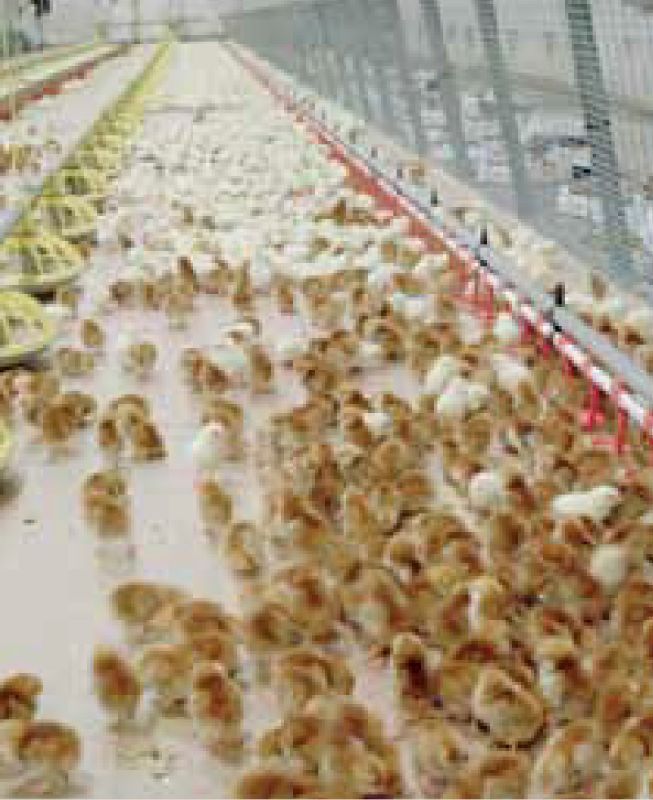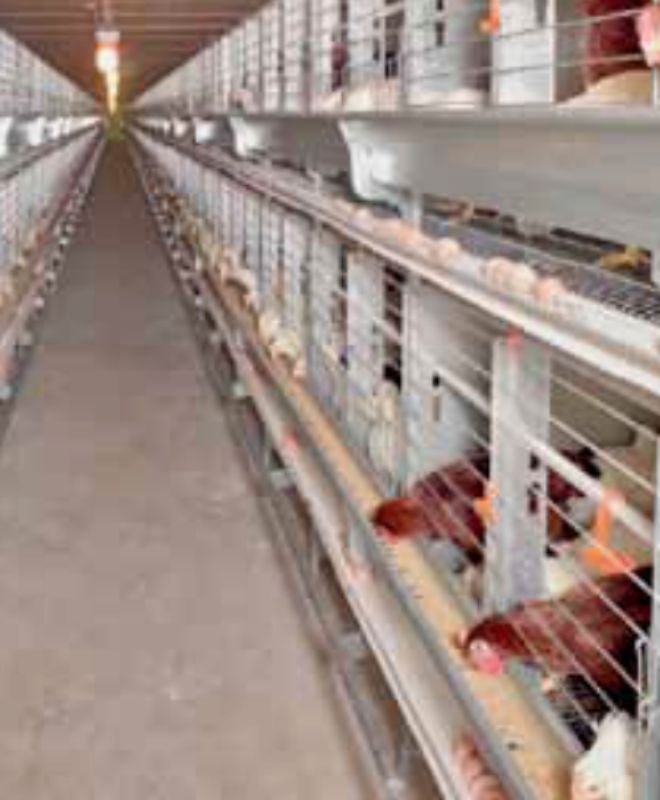Developments of housing systems for parent stock have not ceased. Besides traditional floor housing, several other systems have made their entrance in the layer breeding sector. An overview of the most important housing systems and their key aspects.
Cages
For those who consider switching to a new housing system there are various options. The advantage of the classic cage system is mainly in the rare occurrence of floor eggs. In addition, it offers overview in the poultry house, good climate and hygiene possibilities and a good working environment. “As groups are smaller, social stress occurs less among the birds”, knows LOHMANN TIERZUCHT’s Area sales Manager Pieter-Jan Luykx. “It is possible to divide parent stock into smaller groups when they are kept in cages. This allows several strains of parent stock, such as LOHMANN LsL and LOHMANN Brown, to be kept in the same house, and it makes it easier to separate the different strains.”Point of attention for cage housing
In cage housing (in groups) keeping the legs shape is vital. This is particularly relevant for the males. Usually a male percentage of 6 to 7 percent is sufficient if the quality of the males is correct. Determine the hen-male ratio based on the size of the group. If needed, group size may be varied by combining two or more groups (cages).Veranda system
In the past the standard veranda system, in which birds are confined, showed mixed results. That is why in the Netherlands farmers acquired experience in ‘opening the veranda system’. This involved opening the cages after the acclamation period, which is around 28 – 30 weeks of age, allowing the birds, after opening the cages, to scratch outside their cages. As a result, breeding results improved during the second half of the laying period. The plumage of the hens remained in better condition as male toenails causing feather damage on the back of the female during mating – grow less quickly by scratching the floor. “This combines the benefits of both floor housing and cage housing: minimum floor eggs, the birds show better social behaviour and the poultry house occupancy has improved”, Luykx lists. “Climate can be managed more easily, litter quality is better and the system has labour and management benefits.”Point of attention for cages using a veranda system The veranda system, however, is not cheap.
Plus the concept is not applicable in every house. This is determined by the layout of the house. In general, feed intake is more efficient in cage systems. “Another point of focus is the number of males. They tend to be over-represented in cage- and veranda systems. If you need to to add or switch males, then choose to switch all males in one section, allowing a new social order to be established. A single added male will not be accepted by the other hens and males will not survive.”Non-cage systems
Globally a large number of parent stock is kept in traditional floor systems. These systems occur on every continent, often in a unique, specific set-up, with varying automation levels. For instance, in several countries collecting eggs is not automated.Non-cage systems with aviary systems
The so called aviary system is gaining popularity in the layer parent stock business. This is particularly the case in western europe. This development is mainly driven by the upscaling of parent stock farms and by local regulations concerning dust and ammonia reduction. Aviary systems are often installed in former traditional floor houses. As in traditional floor houses, parent stock may roam freely. By installing multiple row systems additional living layers are created which in turn create additional living surfaces and related nests and feeding and drinking lines. As a result up to twice
the number of parent stock can be kept in the same system. The aviary system offers several variants and most well-established suppliers of stable equipment have one or more equipped aviary system for parent stock. Both the height of and under the system and the position of feed and water in regular aviary systems for laying hens have often been adjusted. After all, the male, being considerably larger than the hen, must live in the system as well. Luykx: “As a floor housing system with aviary system can accommodate more birds, heat production rises. Particularly in countries with cool weather conditions this will lead to a more stable temperature in the poultry house, making it easy to ventilate because there is more warm production caused by higher bird density. Moreover, today all suppliers of floor housing and aviary systems ought to be capable of supplying laying nests which guarantee a perfect egg quality.”
Point of attention for floor houses using aviary systems
There are still risks associated with the transition of eggs from the nest belt to the crossconveyor belt. Transitions must be checked regularly for the correct adjustments. stay focused on this, especially in the production of hatching eggs. This has a direct negative effect on the breeding results.Aviary housing
In comparison with traditional floor housing, aviary housing offers a better climate due to the fact that there is less ammonia in the house. Manure is removed at least once per week and the heat production of the birds allows better ventilation. Optionally the manure on the belts can be additionally dried by aeration. Moreover, aviary systems can also be equipped with manure belts and aeration. This is beneficial to the climate in the house as well. Today, litter can be removed automatically in modern aviary systems. “The litter is partially removed together with the manure”, Luykx explains. “This reduces labour and the risk of floor eggs. It improves the climate in the house, as less dust is produced.”Point of attention aviary system
Keep in mind an aviary system requires a higher truss height than a floor housing system. whether it concerns existing or newly built houses, it is highly recommended to choose a house with sufficient volume and plenty of space above the system, to ensure the airflow is not disturbed.Combination systems
In the past few years the popularity of so called ‘combination systems’ has been rising in commercial layer hen houses. Though they are deployable for parent
animals there is an increased risk of dirty eggs. A hatching egg should be produced in a nestbox. In a ‘combination system’ this is not always the case. It is often difficult or even impossible to keep eggs produced in nests and system separated. This increases the risk the hatching eggs may get contaminated. “If these system eggs get moved onto different conveyors and can be collected separately there is no problem”, Luykx notes. “It is a no-go to put eggs from outside a nest into one. These should be collected separately and put with the second type of egg at all times.”
Management and automation
Keep in mind that management of the different housing systems may vary. “The housing system for the rearing period must be selected with care: cage rearing for cage production and aviary rearing for aviary production. switching from a ground- to a cage system is possible, but is not optimal, in particular for the males”, Luykx says. “systems using manure belts have the distinct disadvantage of a mandatory weekly cleaning. The manure pit is often located under ground. This makes it difficult to clean, which brings with it a variety of risks of vermin in the stable.” These days the discharge belt can be placed on the even floor instead of in a pit. There are also belts on wheels that can be moved after shifting the manure. The belt then stays in the stable and can be closed air-tight. The newest development is a series of central, automatically sealable covers above the discharge belt. After opening the manure will fall through these and onto the belt. This prevents drafts and enhances the climate in the stable. A bad climate enhances the risk of e-coli infections and other diseases, which can be followed by disastrous results. “On modern reproduction farms, the climate should not be a theme but it is still a point of attention”, so Luykx says. “when considering the climate, make sure there is enough space between the system and the floor. This goes for both cage- and aviary systems. This improves air circulation and vermin has no chance to hide.”How to choose a new housing system?
Are you considering to purchase a new system? we would like to offer you some advice to get you started.
› Make an inventory of the key aspects that count as most important to you. A clear overview will help you to make the right choices which enable keeping parent stock over the coming decades.
› A new housing system requires a considerable investment. Therefore, take time to be informed about the latest techniques. examine systems with potential suppliers, but also take the trouble of working in a company with a similar system for several days.
› substantiate your decision with reliable results, facts and experiences of other breeders. Learn from other people’s mistakes.
› Prepare yourself well. This is the first step of mastering the management of the new housing system.
› LOHMANN TIERZUCHT may be of service in this matter.
Pieter-Jan Luykx
Photos provided by Ter Heerdt Hatchery, The Netherlands, Big Dutchman, Germany








